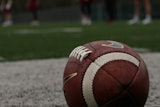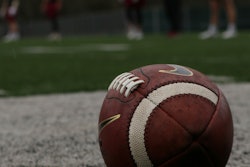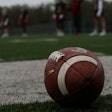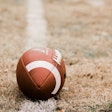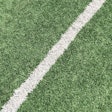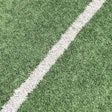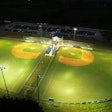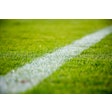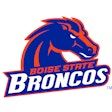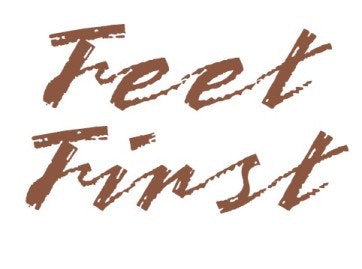
If the hinge on a locker door breaks, you can always pull the door off until you are ready to fix it. If the lowering mechanism on a ceiling-suspended basketball standard jams, you can always roll in a portable unit or set up a half-court game until the damage is repaired. (These actions won't reflect all that well on your program, but they'll work in a pinch.)
But delaying repairs on sports surfaces isn't so easy. You can't really hang an "Out of Order" sign on a soccer field, for example, and short of hiring a pack of dogs and rolling in a portable electrified fence, you probably won't succeed in keeping players off anyway. More than that, though, dragging your feet is downright dangerous. Each player who sets foot on your field is just one misstep from finding that hole, breaking an ankle and suing you for negligence.
What makes even minor repairs on sports surfaces tricky is that these surfaces are (ideally) built for high performance and safety. So while substituting a 1.4-inch bolt for a 5.16-inch bolt might work just fine in certain locker-room applications, using an improper patching compound on a polyurethane track might compromise its ability to perform as intended.
For that reason, manufacturers of sports surfaces recommend leaving most repairs to the professionals. There is, however, much that facility operators can do to fix some problems and forestall others.
GRASS FIELDS Natural playing surfaces for different sports show different types of normal wear. Football fields take their biggest lumps between the hash marks; soccer pitches are punished most at the goal mouths and in officials' running lanes. A regular schedule of aeration, topdressing and overseeding will keep most fields green and healthy, and field managers will often try other techniques to spread the wear around-by moving soccer goals and shifting the placement of whole fields, for example.
Naturally, fields endure abnormal wear as well as normal wear. Games played in wet weather can hasten the demise of a grass field and require more-stringent maintenance measures. (Joyriding teens who want to spin around in daddy's SUV will tend to do so when conditions are already at their wettest.) Small divots can often be dealt with simply by replacing chunks of sod (some field managers push divots back in place by running a reel mower over the field with the reels disengaged), but deeper holes and ruts most often require resodding.
For a relatively simple operation, it's surprising how often sodding is performed incorrectly. A typical mistake is not digging deep enough to place sod at the level of the rest of the field. When sod fails to take-and it happens a lot - there are a number of possible explanations. The subsurface might not have been loosened enough to allow the new sod to take root, the soil profile of the sod might not match the soil profile of the field, or the sod might have been cut too thin or at inconsistent depths. To alleviate several of these problems, many field managers-at every level from the pros to high schools and municipal rec departments - grow their own turf. A typical method is to extend the field in question (beyond the outfield fence, along the sidelines) and maintain it in the same way as the actual field. That way, the turf and soil profile and grass color is as close from the field goes into the ground where the replacement sod was cut, creating a cycle of turf rejuvenation.
Vandalism that destroys the turf plant-the introduction of toxic substances, for example-most often necessitates full-scale resodding. Swift action allows graffiti painted on fields (especially latex house paint) to be removed without replacing sod. Keeping in mind that no more than one-third of a grass blade should be removed in any cutting, quick repetition of mowing and watering to promote new growth-several times a day in sunny weather-will remove enough paint to allow photosynthesis to take place.
SKINNED INFIELDS Think of the earth as a gigantic kiln and you'll begin to see why "bake" is the operative word for infields in summer. The sun's generous heat makes easy work of clay infields, rendering them rock hard in days unless field operators spend the requisite amount of time breaking up the surface with any number of scarifiers and drag mats. At the same time, though, ballplayers find it easy to dig up even the most compacted surface, and holes quickly develop around bases, in front of the pitching rubber and in both batter's boxes. Dragging the infield temporarily fills holes and low spots, but they quickly reappear once the leadoff batter calls time and gets settled at the plate. Filling holes the right way means digging up and removing the loose fill, and then going deeper . enough to replace clay blocks that serve as the foundation of mounds and batter's boxes. The top 1 to 11.2 inches must be built up in 1.4-inch layers, with each layer moistened, shaped and tamped down for a solid, smooth surface.
Low spots and holes that develop often fill with rainwater, adding a second step that is sometimes problematic . removing standing water. Many tools exist to help speed the process, from large stepon sponges to blowers. Severe standing water sometimes necessitates bringing out the big guns . for example, a fencepost auger. Holes can be drilled at various points in a large puddle to allow water to drain through the compacted subbase. Fill holes with less-dense material such as pea gravel or sand, cover with two inches of lightly tamped clay and use a drying agent to allow immediate field use. Calcined clay drying materials work well as a soil additive to soak up moisture after water has been spread from the puddle or removed, but eventually the problem must be dealt with. As with the batter's box, wet clay in these areas must be removed and a new base created. Care must be taken to avoid building up the lip where skinned areas and grass meet. Materials may be removed from the lip with a rake, leaf blower or water hose (if using a blower or hose, stand in the outfield grass and spray loosened material back onto the infield surface), or the sod strip at the infield's edge can be removed and replaced at the proper level.
SYNTHETIC FIELDS Repairs of these systems are best left to their manufacturers, but certain maintenance techniques rate a mention. Although turf fibers can take a lot of punishment, a whole field of fibers is a magnet for capturing foreign substances such as gum, marshmallows, vehicle oils, beverages, tobacco juice and bird droppings. Fortunately, commonsense cleaning techniques for the home translate to the field. Powdered household detergent, at a ratio of about a teaspoon to a quart of warm water, will loosen most minor stains. Use as little liquid as possible and scrub with a clean brush made of synthetic fibers (natural fibers will be more likely to break off and be captured by the turf). Afterward, flush all detergent away from the surface with clean water.
Harder substances such as chewing gum may be removed by freezing with dry ice or aerosol refrigerants available at carpet cleaning suppliers. Work carefully with a flat tool (a putty knife, for example) to remove. Petroleum-based substances, such as tire marks or motor oil, are best handled by the turf manufacturer since their removal may require solvent-based cleaners that are incompatible with some surface systems. Stain removal aside, minor tears are repairs that can be made by anyone handy with a needle (in this case, an upholstery needle) and thread (in this case, heavy-gauge nylon). To close holes and mend seams, a standard loop stitch works well. Push the needle through both pieces of turf but don't pull the stitch tight before passing the needle through the loop. Each stitch, ideally no more than 1.2 inch apart, is thus locked independently, helping keep the tear from returning. Some tears may also require use of an approved adhesive.
HARD-SURFACE TENNIS COURTS Another difficult-to-repair surface, outdoor tennis courts tend to require complete refurbishment rather than a mere touch-up. Patching cracks (the most common minor problem) isn't difficult, requiring a putty knife and a premixed compound available from most court manufacturers. Grass, dirt and other foreign substances should be removed, and cracks filled (wider cracks require multiple applications of filler). Although these materials are colored, matching them is difficult because of the tendency of court coatings to fade in the sun.
Finding a patching material that is compatible with the existing surface and with the coating material that will presumably cover it is a little tricky. Incompatibility rules out materials used to fill cracks in driveways and parking lots; in addition, they can turn soft in summer heat and be easily tracked by shoes to the rest of the court. Further, expansion and contraction rates vary for different types of compounds, meaning that repaired cracks may reappear with a change in the weather.
Some court builders recommend filling cracks with stone screenings (a finely pulverized aggregate) and then topping with a fiberglass mesh before resurfacing. Problems other than cracks, such as low spots that collect rainwater, also must be addressed structurally, with new drainage systems, rebuilt foundations and new surfaces, these builders say. Oxidation, a common court malady, is caused by improperly specified aggregate used to create the court's subbase. Pavement materials containing pyrite or other similar ores will show rust stains through the surface coating. Overlaying the courts with a proper subbase is necessary in such cases.
SYNTHETIC TRACKS Problems with hard-surface tracks built over bituminous pavement, like their tennis-court cousins, usually indicate shortcuts taken at the construction stage and are difficult to repair simply. Tracks are often designed to anticipate future problems, such as grass encroachment or lawnmower nicks - ideally, their design includes a concrete curb, or at least an asphalt base that's extended 1 foot beyond the edge of the all-weather surface.
Patching small tears in a latex surface is done utilizing a patch kit of rubber granules and glue available from the manufacturer, with the mixture troweled into place. Patching urethane surfaces is more technical and is usually left to the system manufacturer. The technique for cleaning stains is similar to that used on synthetic turf - gently scrubbing with a mild detergent and cleaning up soapy residue afterward.
High-powered blowers or mechanical sweepers can aid in cleaning abrasive sand and grit from the surface, helping extend the useful life of these surfaces. One wear characteristic common to most tracks is heavy use of the inside lanes. After surface testing of the outer lane has been performed (to determine the proper physical properties of the inside lanes), the interior lanes can be removed and replaced with compatible materials. A spray coating is then applied to the entire surface and the lanes relined. Contractors prefer the easier whole-track replacement, but replacing just the most worn part of the track can save a facility operator a lot of money.
GYM FLOORS Repair of synthetic gym floors is easy - for a professional. Whether made of sheet rubber, vinyl, or full-pour or sandwiched urethane, these floors utilize chemicals and compounds that should be handled by qualified technicians. Floors made of urethane can be restored by pouring a thin layer of new material over the entire surface, while tears in vinyl and rubber floors can be patched by compression or welding-but again, a facility operator should not attempt these repairs. Both the surface-and the surface warranty-can be damaged beyond repair.
Wood floors in gyms, racquet courts and aerobics studios can be repaired more readily, although certain techniques do require some dexterity.
Recoating of hardwood floors, for example, is simple enough to be performed annually by a number of high school custodians, but takes a great deal of care.
Floors should be swept clean, and watersoluble soils, tape or gum residue should be removed using a damp mop, mineral spirits and a putty knife. Using a singledisc floor machine, abrade the surface of the existing coating with an 80-grit screen, being careful to keep the machine level (if you hit wood or game lines, you've gone too far). Let the dust settle overnight before removing dust with a tackcloth. (A vacuum will have a tendency to throw dust back into the air.) When applying finish, be sure to use a finish that is compatible with the finish already on the floor. Apply finish with a lambswool applicator, following the finish manufacturer's recommendations.
Turn off all air-circulating systems until the finish has dried (dust settling on the finish will mar the surface), and allow ample time for the floor to cure before allowing foot traffic.
Replacement of a damaged board or groups of boards is another task that can be handled by anyone skilled in carpentry. It's an operation typically requiring only a circular saw, chisel, hammer, nails and adhesive, although modern gym floor systems using a variety of clips and subfloor configurations do complicate matters. It would be wise nowadays to consult the floor manufacturer for guidance in this area.
ICE SURFACES The most forgiving sports surface imaginable, ice is easily repaired-bumps can be cut away, holes can be filled with slush, and ice resurfacers effortlessly smooth away imperfections. The primary difficulty in troubleshooting surface problems is locating the source of problems in the building's other systems so that the surface problem doesn't return again and again.
Bumps and soft spots are caused by moisture collecting on ceilings and beams and dripping onto the ice. (Cold water creates stalagmites, warm water turns ice to slush.) Stopping the drip means repairing the rink's air-handling system, installing weather-stripping around doors and windows and caulking gaps at building seams that may be allowing outside air to infiltrate the building envelope. A tried-and-true method of locating gaps is simple-turn off all the lights inside the rink and look for daylight peeking through.
Two other common ice-surface failures are easily dealt with. To keep the rink operational for a time after a refrigeration-system failure, use the resurfacer to scrape ice water, turn off the air circulation system (this will keep cold air at the ice surface and warm air at the ceiling), and shut down as many lights as possible to cut down on heat. A fog problem, which can add moisture to the surface, is dealt with the opposite way-mix up air inside the rink by turning up the air circulation system or turning on exhaust fans (assuming relative humidity outside is low).
SURFACE SOLUTIONS On all surface types, regular maintenance won't prevent problems from occurring, but it will help keep damage to a minimum. Basic housekeeping for surfaces means a regular schedule of trash removal, spot cleaning and sweeping, as well as the removal of weeds that can choke outdoor tennis courts and tracks, and maintenance of building systems to control swings in humidity that can compromise the performance of wood floors and ice surfaces. Although these steps barely scratch the surface of possible preventive maintenance techniques, they'll go a long way toward providing safe, playable surfaces for your program's participants.













